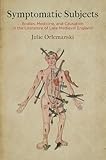Symptomatic Subjects : Bodies, Medicine, and Causation in the Literature of Late Medieval England / Julie Orlemanski.
Material type: TextSeries: Alembics: Penn Studies in Literature and SciencePublisher: Philadelphia : University of Pennsylvania Press, [2019]Copyright date: ©2019Description: 1 online resource (344 p.) : 4 illusContent type:
TextSeries: Alembics: Penn Studies in Literature and SciencePublisher: Philadelphia : University of Pennsylvania Press, [2019]Copyright date: ©2019Description: 1 online resource (344 p.) : 4 illusContent type: - 9780812296082
- Causation in literature
- Causation
- Diseases -- England -- Causes and theories of causation -- History -- To 1500
- English literature -- Middle English, 1100-1500 -- History and criticism
- Human body in literature
- Literature and medicine -- England -- History -- To 1500
- Literature, Medieval
- Medicine, Medieval
- History-Medieval 500 to 1500
- Literature (Scholarly)
- LITERARY CRITICISM / Medieval
- Cultural Studies
- History
- Literature
- Medicine
- Medieval and Renaissance Studies
- 610.9 23
- R702
- online - DeGruyter
| Item type | Current library | Call number | URL | Status | Notes | Barcode | |
|---|---|---|---|---|---|---|---|
 eBook
eBook
|
Biblioteca "Angelicum" Pont. Univ. S.Tommaso d'Aquino Nuvola online | online - DeGruyter (Browse shelf(Opens below)) | Online access | Not for loan (Accesso limitato) | Accesso per gli utenti autorizzati / Access for authorized users | (dgr)9780812296082 |
Frontmatter -- Contents -- Abbreviations -- Introduction -- Part I. Thinking with Phisik -- Part II. Playing with Phisik Chapter -- Part III. Emplotting Phisik -- Part IV. Personalizing Phisik -- Coda -- Notes -- Works Cited -- Index -- Acknowledgments
restricted access online access with authorization star
http://purl.org/coar/access_right/c_16ec
In the period just prior to medicine's modernity—before the rise of Renaissance anatomy, the centralized regulation of medical practice, and the valorization of scientific empiricism—England was the scene of a remarkable upsurge in medical writing. Between the arrival of the Black Death in 1348 and the emergence of printed English books a century and a quarter later, thousands of discrete medical texts were copied, translated, and composed, largely for readers outside universities. These widely varied texts shared a model of a universe crisscrossed with physical forces and a picture of the human body as a changeable, composite thing, tuned materially to the world's vicissitudes. According to Julie Orlemanski, when writers like Geoffrey Chaucer, Robert Henryson, Thomas Hoccleve, and Margery Kempe drew on the discourse of phisik—the language of humors and complexions, leprous pustules and love sickness, regimen and pharmacopeia—they did so to chart new circuits of legibility between physiology and personhood.Orlemanski explores the texts of her vernacular writers to show how they deployed the rich terminology of embodiment and its ailments to portray symptomatic figures who struggled to control both their bodies and the interpretations that gave their bodies meaning. As medical paradigms mingled with penitential, miraculous, and socially symbolic systems, these texts demanded that a growing number of readers negotiate the conflicting claims of material causation, intentional action, and divine power. Examining both the medical writings of late medieval England and the narrative and poetic works that responded to them, Symptomatic Subjects illuminates the period's conflicts over who had the authority to construe bodily signs and what embodiment could be made to mean.
Mode of access: Internet via World Wide Web.
In English.
Description based on online resource; title from PDF title page (publisher's Web site, viewed 25. Jun 2024)


